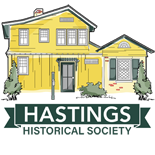
By Mark Sameth

Abraham Lincoln was here. More precisely, he passed through here. Four times. This winter marks the 160th anniversary of Lincoln’s first passage through – as it was known then – “Hastings-Upon-Hudson,” as President-elect aboard The Inaugural Express a little after 2:30 PM on the afternoon of February 19, 1861.

The Inaugural Express was not one, but rather a series of trains that were to carry Lincoln on a circuitous trip from Springfield, Illinois to Washington, DC. (Owing to reports that assassins were waiting in Baltimore, plans were changed and Lincoln travelled the final 12-hour stretch – from Harrisburg, to Philadelphia, to Baltimore, to Washington, DC – incognito, via a series of unmarked private and public passenger trains, arriving in the capital on February 23nd at 6 AM.)
The President-elect and the Lincolns’ eldest son Robert began the 13-day journey in Springfield on the morning of February 11th, along with Lincoln’s valet William Henry Johnson, with Lincoln’s wife Mary and their younger sons Willie and Tad waiting to join them in Indianapolis. After travelling through Illinois and Indiana, the train made its way through Ohio, Pennsylvania, and western New York. There, in the town of Westfield, Lincoln met 12-year-old Grace Bedell – the young girl who a few months earlier had written the then-candidate suggesting he grew out his whiskers.
On February 18th, newspaper man Horace Greeley boarded the train in Buffalo, travelling with the party and interviewing the President-elect for the second time. Later that same day in Syracuse, standing on the platform of the train, Lincoln shook the hand of 97-year-old Reverend Daniel Waldo, who had the remarkable (but not utterly unique) distinction of having voted for both Washington and Lincoln.
By the morning of February19th the travelling party, having left Albany, was in Troy, where they boarded a specially prepared train of the Hudson River Railroad for the day trip to New York City. According to a New York Times article dated February 20th:
“When the party reached the Hudson River train, much gratification and surprise was expressed by Mr. Lincoln at the arrangement made for his accommodation. The car provided was one of the handsomest, perhaps, ever run in this country. The decorations are blue, with silver stars, and the rich sofas, carpeting and luxurious chairs give to the car the appearance of an elegantly furnished saloon. The sides are draped with red, white, and blue silk, and national flags are suspended at each end. The locomotive Young America went ahead as pilot, and the train was drawn by the handsome locomotive Union, which was splendidly decorated with flags.”

The train made only a few stops – in Rhinebeck, Hudson, Poughkeepsie, and Fishkill – and Lincoln spoke briefly, if at all. When at 2 PM they pulled into Peekskill, he was induced to leave the car, step onto a baggage truck pulled up parallel to his train car as a speaking platform, and address the crowd, but again he offered but a few words (138 to be exact). The train then departed and continued travelling over 60 miles per hour.
It was at about 2:35 PM on the 19th that The Inaugural Express passed through Hastings, where it ran alongside the Hudson River Steam Sugar Refinery on the waterfront in our village.

Up the hill, many of today’s familiar Hastings sights were already standing. These included:
- The three circa-1847 cottages on the south side of Washington Avenue (beginning at the corner of Broadway), built as rental properties by Henry Draper, one of which would in a few months be home to Commander (later Admiral) David Glasgow Farragut and his family;
- The world-famous circa-1860 astronomical observatory on Draper’s estate, home today to the Hastings Historical Society;
- Another house on Washington Avenue (# 49, built in 1835) which would later be the residence and studio of Hudson River School artist Jasper Crospey (he would name it “Ever Rest”);
- And, at Five Corners, Hastings’ first church building, which was erected in 1850. Originally called the Dutch Reformed Church, it would be the site of an official reception in 1865 for Farragut upon his return from the Civil War.
Jasper Cropsey was living abroad in London in 1861. But he had already painted many of his well-known Hudson River scenes, including one of Dudley’s Grove, which the Lincoln train was about to pass, just south of the Hastings train station. Dudley’s Grove was a popular destination for steamboat excursions of the day. These steamboats would sail up the Hudson from New York City with working-class passengers looking to escape the summer heat, enjoy the grove’s shaded picnic tables, and otherwise recreate. The resort was later popularized in song:
“The young men’s social club, they gave a grand excursion / They had a band from Monahan, two barges and a boat / The lads were tittivated, yes, full of sweet diversion / I’d Kitty McGlone away from home in a linen overcoat” (Up at Dudley’s Grove)

South of Dudley’s Grove, newspaper reports said that the train, which had been making good time, slowed as it passed through Yonkers “amidst firing of cannon, music, and cheering, Mr. Lincoln standing on the rear platform.” The train went by Philips Manor Hall, once home to the notorious slave trader and British loyalist Frederick Philipse, who owned a vast manor from Yonkers to Croton before the Revolutionary War.

According to the same NYT piece mentioned earlier, “at the Female Orphan Asylum [a precursor to today’s Graham-Windham, although located further south than the current institution] the children were all drawn up in line outside the building, and the cars made a minute’s pause in order to allow Mr. Lincoln to be seen.” A few minutes later, just south of Yonkers, the train crossed a wooden drawbridge, which had been built over Spuyten Duyvil by the New York and Hudson River Railroad in 1849.

And then at 3 PM, right on time, The Inaugural Express pulled into Manhattan’s 30th Street depot, on the south side of the street between 9th and 10th Avenues. Lincoln was the first official passenger to pass through the newly built – and on that day festively and patriotically decorated – depot. Thirty-five carriages were there to transport the President-elect and his party to the Astor Hotel, on Broadway south of City Hall, for two and a half days of meetings, public appearances, and a night at the opera before the inaugural journey continued.

Mark Sameth is a long-time resident of Hastings with an interest in all things historical. An ordained rabbi, he is the author of “The Name: A History of the Dual-Gendered Hebrew Name for God.”









Wow, what a nice piece of Hastings on Hudson history ( albeit brief) that I never was aware of.very interesting trip !
Cool, right? We didn’t know about this either, until Mark brought it to our attention!
Love stories like this. Thanks so much for documenting our history!
Thank you. very interesting.
Wonderful compilation of text and photos from the time.
This information has just added to my memories growing up on the Hudson and Hastings with all its history.
Thanks so much.
What a very interesting article. I went to the First Reformed Church and knew it a once called the Dutch Reformed Church but was not aware that It was built during this time. Keep these great articles coming.
Very interesting!
I am disappointedly in form to think that Metro North/ MTA or Port Authority hasn’t ever considered or dedicated a Hudson train name or train line in honor of our great President Lincoln. Shame, Shame, Shame!
Thank you so much for sharing all of the informative histories of where I grew up and in my mind never really left
Pingback: Abraham Lincoln’s Second and Third Passages Through Hastings: A Secret Rendezvous – Hastings Historical Society